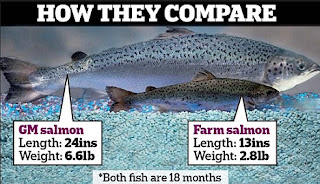Genetically Modified Salmon
Two years ago, there was a huge debate in the US about should
the government approve and introduce the genetically modified (GM) salmons for
people to eat (O’Neil & Kimbrell, 2011).
GM salmons are one of the major applications of genetic
engineering. Scientists introduce a desired trait to the wild salmons by
manipulating its genome using genetic engineering technique to introduce Chinook’s DNA to an Atlantic salmon. The
DNA is manipulated by polymerase chain reaction (PCR).
PCR is a 3-step cycle. Billions of copies of specific
segment can be quickly replicated in few hours. Desired RNA of Chinook salmon
is chosen, isolated and amplified by PCR. First, the reaction mixture is heated
to denature the DNA strands, then it is cooled down to allow hydrogen bonding
of single-stranded short DNA primers complementary to sequences on the opposite
strands at each end of the target sequence. At last, target sequences are
extended by adding nucleotides with DNA polymerase in the 5’ to 3’ direction
for extension. The reaction is possible because of the heat-stable Taq
polymerase was discovered. Taq polymerase lives in hot springs so it can
withstand the heat in the first step of the cycle.
Figure 1 Illustration
of the Polymerase Chain Reaction (Reece et
al., 2012)
The plasmid is then constructed with selectable marker gene,
which contains the promoter and terminator. Transcription is initiated by the
promoter region and terminated in the terminator region. The promoters allow GM
salmons have the growth hormone that it normally would not and it allows them
to grow twice the size than wild Atlanta salmons in a fast rate (Madin 2011).
The Plasmid DNA with new genes can be inserted into bacterial cells and the
bacteria will then express the genes.
Figure 2 Comparison
of GM salmon and farm salmon (Thompson 2011)
There are lots of controversies on whether or not GM salmon
is safe to consume. Up to date, there is no concrete evidence that it is
harmful to human, as it is quite impossible to carry out controlled experiments
due to our mixed diet (Thompson 2011). Another big concern is the environmental
risks of wild salmons extinction. People feared that if they escaped to the
natural environment, they might compete with the wild salmons for food and wild
salmons would not survive as food source become more scarce. Also, there may be
a change in the food chain due to change in prey some animals and eventually
affect the whole ecosystem.
Though there are many controversies on GM salmons on food
safety and risks to the environment. There would be lots of benefits if a
stable food source can be created, for instance solving food crisis in third
world countries. With more research and trials, scientists are trying to
collect more experimental data to see what will occur to the genetics of GM salmons
after breeding. Hopefully one day it can be proven that GM salmons pose no risk
to human health and the nature.
Bibliography:


